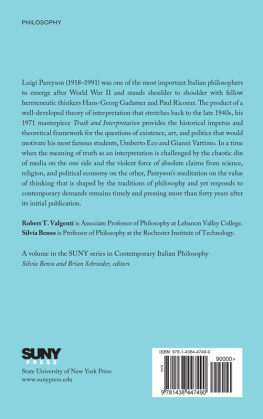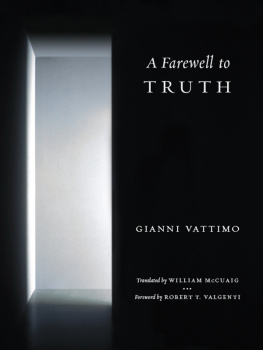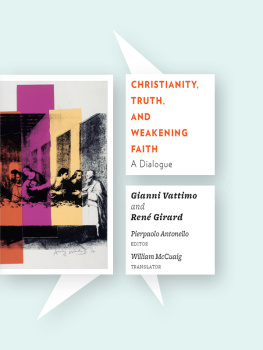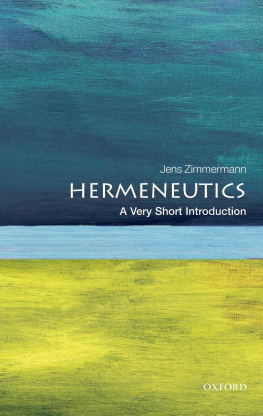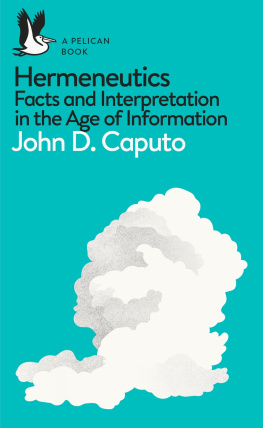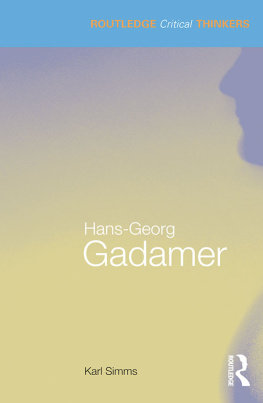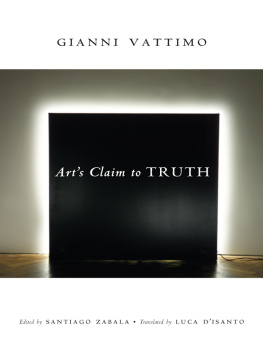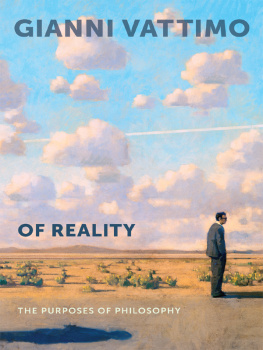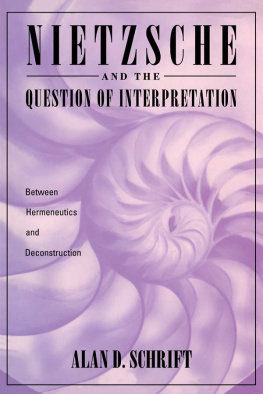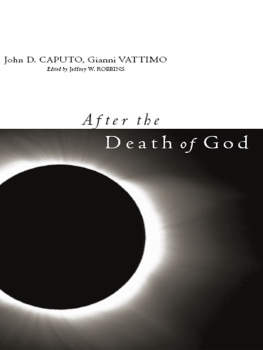Truth and Interpretation
SUNY series in Contemporary Italian Philosophy
Silvia Benso and Brian Schroeder, editors
Truth and Interpretation
Luigi Pareyson
Translated and with an Introduction by
Robert T. Valgenti
Revised and Edited by
Silvia Benso
Foreword by
Gianni Vattimo
2005 Ugo Mursia Editore S.p.A - Verit e interpretazione by Luigi Pareyson
Published by State University of New York Press, Albany
2013 State University of New York
All rights reserved
Printed in the United States of America
No part of this book may be used or reproduced in any manner whatsoever
without written permission. No part of this book may be stored in a retrieval system
or transmitted in any form or by any means including electronic, electrostatic,
magnetic tape, mechanical, photocopying, recording, or otherwise without the prior
permission in writing of the publisher.
For information, contact State University of New York Press, Albany, NY
www.sunypress.edu
Production by Eileen Nizer
Marketing by Fran Keneston
Library of Congress Cataloging-in-Publication Data
Pareyson, Luigi.
[Verit e interpretazione. English]
Truth and interpretation / Luigi Pareyson ; translated and with an introduction by Robert T. Valgenti ; revised and edited by Silvia Benso; foreword by Gianni Vattimo.
pages cm (Suny series in contemporary Italian philosophy)
Includes bibliographical references and index.
ISBN 978-1-4384-4749-0 (hardcover : alk. paper)
1. Truth. 2. Ideology. I. Valgenti, Robert T. II. Title.
BD171.P3713 2013
121dc23
2012037054
10 9 8 7 6 5 4 3 2 1
Contents
Acknowledgments
There are many who have been instrumental to the idea and execution of this long-overdue translation. In particular I would like to thank Claudio Ciancio, Marco Ravera, Maurizio Pagano, Francesco Tomatis, Gianluca Cuozzo, Ezio Gamba, and all those at the Centro Studi Filosofico-Religiosi Luigi Pareyson in Turin, whose generosity, time, and resources in 2001 and again in 2005 helped to initiate this project; the Department of Philosophy at DePaul University, and the Office of Academic Affairs at Lebanon Valley College, who in varying stages of this project provided the time and financial support necessary for this work; my colleagues in the Department of Religion and Philosophy at Lebanon Valley CollegeNoel Hubler, Jeffrey W. Robbins, Nolle Vahanian, and Matthew Sayerswho deserve special recognition for creating and supporting an environment where such work can thrive; Anthony Feudale, for his careful and timely work on the index; and Gaetano Chiurazzi and Santiago Zabala, who have served as trustworthy guides and colleagues in this long process. Of course, I am indebted to Gianni Vattimo, who many years ago first suggested I study his teacher Pareyson and undertake this translation, and whose mentorship over the years has been invaluable and inspiring. I especially want to thank Silvia Benso for her expert and patient editing of this text, which was absolutely essential to the successful translation of Pareysons profound and often difficult thinking.
Translators Note
In the following translation I have tried to remain true to the language and intent of Pareysons original. When appropriate, I have provided the original Italian word in brackets to indicate a particularly difficult and/or important term in the work. I have retained Pareysons original notes, placing them at the end of each of the works sections. When possible, I have provided the English-language references and translation of quotations, placing those in brackets in his notes. Where Pareysons original included non-Italian words or quotations, I have retained the original Greek, Latin, German, or French but provided the appropriate translation: from extant English translations if available, or in certain cases, my own translation.
Foreword
Gianni Vattimo
Translated by Silvia Benso
There are no facts but only interpretations. And this too is an interpretation. Most likely, Luigi Pareyson would have never subscribed to this famous claim by Nietzsche although (considering myself loyal to his philosophy) I think that he should have at least confronted it.
We speak, however, from a place that is only partially still similar to the one from which Pareyson spoke, in the early seventies of the last century. What we share with the original situation of his Truth and Interpretation is what I consider to be the still unsurpassable timeliness of hermeneutics.
What we experience today, and was not equally present in the cultural climate of forty years ago, is probably a hardening of the realm of facts. This circumstance reduces some of the urgency of Pareysons rejection of praxis and of the enslavement of philosophy to politics in order to defend instead the transcendence and eternity of truth.
We should not forget that Truth and Interpretation was originally published in Italian in 1970, that is, immediately after the protest movements that had occurred in universities (and later in factories) throughout the Western world starting in 1968. Not without some good reason, Pareyson suspected (and of a similar mind was also an intellectual such as Pier Paolo Pasolini) that the youth protest movement was merely a way of asserting ones right to a more consumerist society, more tolerant but certainly also more American and subjected to the rules of dominating monopolistic capitalism. The student movements proposal of a reformation of the university system seemed to him (and to us) to be in the end inspired by an American, productivistic model that risked destroying, together with the university chair barons [i baroni delle cattedre], also the patrimony of typically European values. It is not by chance that, some years later, one of Bushs ministers would scornfully dismiss such values as things belonging to old Europe, no longer fit for the modern world (of the Iraqi and Afghan wars).
Already at that time, Pareysons position in those years (and on those issues) seemed to me to be the view of an enlightened conservativewhom I always respected since I knew of his anti-fascist involvement (he had been part of the Italian Resistance movement against Fascism and the Nazis when he was a high school teacher in Cuneo), but whose political convictions I could not share. In his insistence on the transcendence and eternity of truth, which he coupled with the great claim that of truth, there is only ever interpretation, and there is no interpretation, lest it be of truth (Truth and Interpretation, ), I forebode, and perceive even more clearly today, the persistence of a metaphysical residue that will be more frankly dissolved, I think, in his later ontology of freedom.
When thinking of Pareysons lesson today, the question I once again ask myself is this: Can we think of hermeneutics in such radical terms as his (of truth, there is only ever interpretation, etc.) and not assert at the same time, as Pareyson conversely did, the transcendence and eternity of truth?
What I name, or what appears to me as a metaphysical residue in Pareysons philosophy of those years is the fact of still thinking of truth as substance, that is, in the end as a permanent being, somewhat like the existing God of Christian dogmatics. A thesis that Pareyson probably never considered is the one expressed in Dietrich Bonhoeffers famous claim that Einen Gott den es gibt, gibt es nicht

